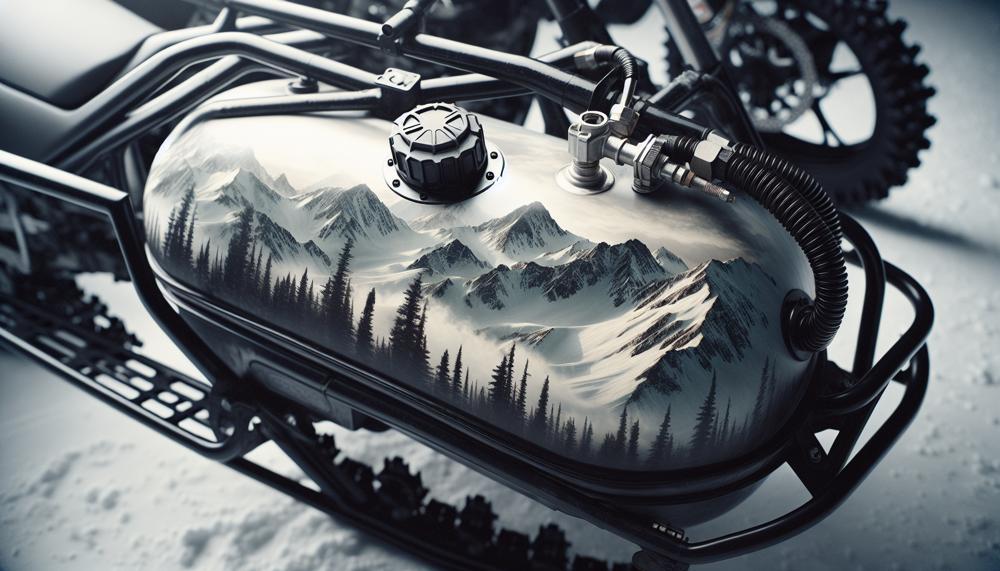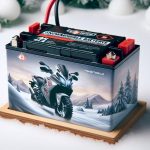Do you find yourself constantly filling up your snowmobile’s gas tank and wishing for better fuel efficiency? We have some insider tips and tricks to help you maximize your snowmobile’s range on a single tank of gas.
So, how far can a snowmobile go on a tank of gas?
The distance a snowmobile can travel on a tank of gas depends on the model and how it’s used:
- Average snowmobile: Uses 10–20 gallons of gas per hour and can travel 70–300 miles on a tank of gas.
- Hard riding: One user reported getting about 120 miles on a tank of gas.
- Packed snow: Can travel 2–3 times farther than deep powder.
- Rotax 900 ACE engine: Can travel about 340 kilometers per tank of gas.
- Ski-Doo 600r: One user reported getting 100 miles on a tank of gas.
By following these expert tips, you can enjoy longer rides without constantly stopping for gas. So gear up and hit the trails with confidence, knowing that every drop of fuel is being put to good use.
Does a snowmobile run on gas?
Contents
- 1 Does a snowmobile run on gas?
- 2 Do snowmobiles need premium gas?
- 3 Do snowmobiles use mixed gas?
- 4 What kind of gas does a snowmobile use?
- 5 How much gas does a snowmobile use?
- 6 How to mix gas for snowmobiles?
- 7 How far can a snowmobile go on a tank of gas?
- 8 What is the best gas to run in a snowmobile?
- 9 Can I run 100 octane in my snowmobile?
- 10 Is ethanol bad for snowmobiles?
- 11 Conclusion
When it comes to choosing the right fuel for your snowmobile, it’s essential to understand how different types of fuel can impact its performance. High-octane fuels provide a significant boost in power and performance, making them ideal for more aggressive riders or those who want to push their snowmobile to its limits.
However, if you’re looking for better fuel efficiency and longer range, opting for a snowmobile with a smaller engine and less horsepower may be a better choice.
The terrain you ride on also plays a crucial role in determining your snowmobile’s range. Riding on flat terrain with minimal obstacles will use less fuel compared to riding on hilly or mountainous terrain with steep inclines and declines. Similarly, harsh weather conditions like strong winds and heavy snowfall can reduce your snowmobile’s mileage by increasing drag and resistance.
In addition to these factors, your riding habits can also impact your snowmobile’s fuel efficiency. Aggressive riding, such as frequently accelerating and braking, can use more fuel compared to a smoother and more consistent riding style. The size and design of the snowmobile itself can also play a role in its range, with larger and heavier models typically using more fuel.
Overall, understanding the various factors that can impact a snowmobile’s range is crucial for planning your trips and ensuring you have enough fuel to reach your destination.
The answer is not a simple yes or no. While most snowmobiles can run on regular gas, premium gas may be necessary for certain types of engines. This is especially true for sport trail, mountain, or crossover snowmobiles with high-performance engines.
So why might premium gas be necessary?
Firstly, it has a higher octane rating than regular gas, usually ranging from 91-93 compared to 87 octane for regular gas. This higher octane level helps prevent engine knocking and allows the engine to run more efficiently.
Additionally, premium gas can provide more power and performance for snowmobiles with high-performance engines or those designed for racing or extreme terrain. The higher octane levels allow the engine to produce more power without risking damage from knocking.
Some premium gas options do not contain ethanol, which can be corrosive to certain types of snowmobile engines. Using premium gas without ethanol can help protect against potential engine damage.
Do snowmobiles use mixed gas?
While snowmobiles do require a specific type of fuel to operate, it is not always mixed gas. The type of fuel needed varies depending on the specific snowmobile and its engine.
Several factors, such as the octane rating, presence of ethanol, and manufacturer’s recommendations, must be considered when determining the best fuel for a snowmobile. To ensure high-quality fuel, it is important to refer to the owner’s manual and purchase from popular gas stations.
It is also crucial to note that some snowmobile engines may be more sensitive to lower quality fuel, which can result in damage and affect overall performance. Therefore, using the recommended fuel type is crucial for optimal performance.
| Recommended Fuel Types for Snowmobiles | Octane Rating | Other Considerations |
| Regular Gasoline | 87 | Compatible with most modern snowmobile engines |
| Premium Gasoline | 91+ | May be necessary for high-performance snowmobiles or extreme terrain |
| Ethanol-Free Gasoline | N/A | Best for two-stroke engines and avoiding ethanol-related issues |

To ensure a smooth and enjoyable ride on your snowmobile, it is crucial to use the correct type of fuel. By following these recommendations and using high-quality fuel, you can avoid potential damage and maximize performance.
So, be sure to refer to your owner’s manual and purchase from reputable gas stations for the best results.
What kind of gas does a snowmobile use?
Snowmobiles primarily utilize gasoline, diesel, or electric power as their fuel sources. It is crucial to select the appropriate type of fuel for your snowmobile as it can significantly impact its performance, maintenance, and environmental footprint. Using the wrong type of fuel can lead to reduced acceleration and top speed, higher maintenance demands, and potential engine damage.
Gasoline is the most commonly used fuel for snowmobiles and is typically recommended for two-stroke engines. It has a higher octane rating, allowing it to withstand greater compression ratios without igniting prematurely. This results in a smoother and more robust ride. However, it is essential to check the ethanol content in gasoline as excessive levels can cause engine performance issues and corrosion.
Diesel fuel is frequently utilized in four-stroke engines due to its lower compression ratio. It is also more efficient than gasoline, resulting in better fuel economy. However, diesel-powered snowmobiles generally have a lower top speed compared to their gasoline-powered counterparts.
Electric power is another alternative for snowmobiles and offers a cleaner and more sustainable option. Electric snowmobiles produce zero emissions and have significantly lower maintenance requirements than traditional fuel-powered ones. However, they do have limited range and require frequent charging.
Selecting the appropriate fuel for your snowmobile not only ensures optimal performance but also contributes to reducing environmental impact.
How much gas does a snowmobile use?
Snowmobiles are not renowned for their impeccable fuel efficiency, unlike other types of vehicles. Due to their original design as utility vehicles rather than recreational ones, they prioritize power and performance above fuel efficiency.
Nonetheless, the fuel efficiency may vary depending on the snowmobile’s type and features. Below is a breakdown of the different types of snowmobiles and their average fuel efficiency:
| Style of Snowmobile | Average Fuel Efficiency | Notes |
| Junior | 15-20 MPG | Compact and lightweight with limited speeds for safety purposes. |
| Mid-sized | 12-18 MPG | Slightly larger than junior snowmobiles with similar speed limitations. |
| Trail | 10-15 MPG | Basic models suitable for beginners. |
| Performance | 8-12 MPG | Rapid speeds and sharp handling for experienced riders. |
| Mountainous | 6-10 MPG | Built for deep snow and steep terrain with powerful engines and long tracks. |
| Mixed-use | 10-14 MPG | A balance between on-trail and off-trail riding. |
| Touring | 8-12 MPG | Luxurious features for long-distance travel. |
| Utility | 6-10 MPG | Rugged machines used for work purposes. |
Despite not being the most fuel-efficient vehicles, snowmobiles offer unique advantages and experiences for riders.
Moreover, advancements in technology and alternative fuel options such as electric power are making them more environmentally friendly and sustainable.
How to mix gas for snowmobiles?
It is crucial to get the right ratio when mixing gas for snowmobiles. The recommended ratio by AMSOIL, a leading manufacturer of synthetic lubricants for snowmobiles, is 50:1. This means no oil should be added to the gasoline as it already contains the necessary lubricants. With this conservative ratio, you can ensure clean combustion and maximum wear protection for any 2-cycle snowmobile engine, regardless of the original oil/gas mix ratio recommended by the snowmobile manufacturer.
Not only does using the proper gas mix ratio impact performance, but it also affects fuel efficiency. Adding too much oil can lead to carbon build-up, fouled spark plugs, and reduced power and acceleration. On the other hand, not enough oil can result in engine damage and excessive wear. By following the recommended ratio of 0:1, you can guarantee optimal engine performance and longevity.
The type of oil used also plays a significant role in a snowmobile’s overall performance and fuel efficiency. Synthetic oils, such as AMSOIL, are specifically designed for snowmobile engines and offer superior protection compared to conventional oils. They burn cleaner, resulting in less carbon build-up and improved fuel efficiency.
Aside from using the correct gas mix ratio, other factors that affect fuel efficiency include engine type, displacement, weight, design, and environmental conditions. For optimal fuel economy, it is recommended to operate a snowmobile at steady speeds.
Proper maintenance also contributes to improved fuel efficiency by regularly changing the oil and cleaning or replacing air filters.
How far can a snowmobile go on a tank of gas?
There are a variety of factors that can influence the distance a snowmobile is able to cover on a single tank of fuel. These include:
- Model of the snowmobile: The make and model of a snowmobile can significantly impact its fuel efficiency. High-performance models with larger engines may consume more fuel and cover a shorter distance on a full tank compared to standard models.
- Terrain and weather conditions: The type of terrain and weather conditions can also play a significant role in how far a snowmobile can travel on a tank of gas. Smooth, flat terrain and colder temperatures can increase fuel efficiency, while rougher terrain and warmer temperatures can decrease it.
- Fuel tank size: The size of the fuel tank is a crucial factor in determining the distance a snowmobile can cover on a single tank of gas. Larger tanks allow for greater range, while smaller tanks may require more frequent refueling stops.
- Riding style: Aggressive riding and higher speeds can burn fuel at a faster rate, reducing the distance a snowmobile can travel on a full tank. Riding at a moderate pace and avoiding sudden bursts of speed can help conserve fuel.
- Type of snowmobile: Different types of snowmobiles (such as performance, touring, or trail models) have varying levels of fuel efficiency. Depending on the type, one can expect to cover anywhere from 88 to 165 miles on a full tank.
- Extra weight or cargo: Carrying additional weight or cargo on a snowmobile can also impact its fuel efficiency and decrease the distance it can travel on a full tank.
By taking into account these various factors, riders can better estimate how far their snowmobile can go on one tank of gas and plan accordingly. It is also important to carry extra fuel for safety in case of unexpected delays or challenges during the ride.
What is the best gas to run in a snowmobile?
When it comes to getting the best performance and fuel efficiency out of your snowmobile, the type of gasoline you use is crucial. The manufacturer’s recommendation for the specific type of gas and octane rating to use is key. Following these guidelines outlined in the owner’s manual will ensure that your snowmobile’s engine is running smoothly and efficiently, preventing any potential damage from using the wrong type of gas.
To ensure high-quality fuel, it is recommended to use popular gas stations that meet industry standards. It’s also important to consider the type of snowmobile you have, as some models may be more sensitive to low-quality gas. While modern engines may have sensors and computers that can adjust for different types of gas, it’s still best to stick with the manufacturer’s recommendation.
For two-stroke engines, it’s essential to use ethanol-free gas. Ethanol can be harmful to these engines, so it’s best to avoid it altogether. While premium gasoline may contain additives, using a higher octane than recommended will not improve performance and can actually decrease fuel efficiency.
When storing your snowmobile for an extended period of time, it’s important to use additives if the fuel contains ethanol. This will prevent any potential damage that may occur from storing a snowmobile with ethanol fuel. Additionally, regular checks on the oil injection system are necessary, and older snowmobiles may require direct oil addition to the gas.
A proper summer storage routine includes draining old gas and cleaning the tank to ensure optimal performance when it’s time to use the snowmobile again. By following these recommendations and using high-quality gas, riders can ensure their snowmobile runs smoothly and efficiently for their next adventure.
| Factors to Consider | Recommended Gasoline Type |
| Snowmobile model | Manufacturer’s recommended gasoline |
| Terrain | Manufacturer’s recommended gasoline |
| Fuel tank size | Manufacturer’s recommended gasoline |
| Riding style | Manufacturer’s recommended gasoline |
| Type of snowmobile | Manufacturer’s recommended gasoline |
| Extra weight or cargo | Manufacturer’s recommended gasoline |
| Storing for extended period of time | Additives and ethanol-free gasoline (if applicable) |
| Oil injection system maintenance | Regular checks and potential oil addition to gasoline (for older snowmobiles) |
| Summer storage routine | Draining old gasoline and cleaning tank |
Can I run 100 octane in my snowmobile?
In fact, using 100 octane fuel in a snowmobile designed for lower octane levels can potentially decrease performance and even cause damage to the engine.
Possible Advantages of Using 100 Octane Fuel:
- Higher octane levels can deliver more power and improved performance in high-performance engines.
- Premium gasoline often includes additives that can enhance engine function and prevent issues like knocking or pinging.
Disadvantages of Using 100 Octane Fuel:
- More expensive compared to regular gasoline.
- May not provide any noticeable benefits in snowmobile engines that are not specifically designed for high octane fuel.
- Can potentially harm the engine if used inappropriately.
Safety Considerations:
It is crucial to always adhere to the recommended octane level for your snowmobile to ensure safe operation.
Using a higher octane fuel can lead to problems such as pre-ignition, which can cause severe damage to the engine and pose a potential safety hazard.
Is ethanol bad for snowmobiles?
When it comes to using ethanol fuel in snowmobiles, there are potential negative effects that should be taken into consideration. These include decreased engine performance, potential engine damage due to moisture attraction, shorter shelf life, increased carbon dioxide emissions, and a negative impact on the environment through resource consumption and pollution.
For snowmobilers, the use of ethanol fuel can be a major concern. Not only does it affect the performance of the vehicle, but it can also have detrimental effects on the environment.
The main reason for this is that ethanol has a high affinity for water, which means it can draw moisture from the air and cause problems for the engine.
In addition to this, ethanol fuel has a shorter shelf life compared to traditional gasoline. This means that if you plan on storing your snowmobile for an extended period of time, you may run into issues with the fuel going bad. This can lead to starting problems and even engine damage.
But it’s not just the performance of your snowmobile that is affected by ethanol fuel. The production of ethanol requires a significant amount of resources and energy, leading to increased carbon dioxide emissions and pollution. This has a negative impact on the environment and contributes to climate change.
Conclusion
In conclusion, by implementing proper maintenance, using high-quality fuel, and practicing good riding habits, you can significantly increase the range of your snowmobile on a single tank of gas.
Regular tune-ups, opting for high-octane gasoline, maintaining a consistent speed, and avoiding prolonged idling are all effective ways to improve fuel efficiency. Additionally, investing in aftermarket parts can also enhance your snowmobile’s performance and save you more gas.
However, with these expert tips in mind and choosing the right fuel for your snowmobile, you can confidently hit the trails knowing that every drop of gas is being utilized efficiently.






